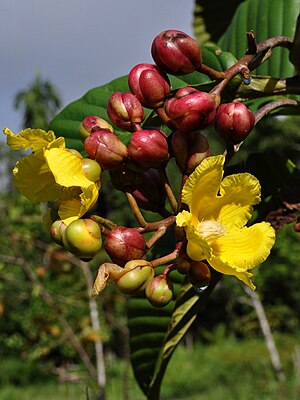Benutzer:Shi Annan/Dillenia suffruticosa
Wenn du dies liest:
|
Wenn du diesen Artikel überarbeitest:
|
| Simpoh ayer | ||||||||||||
|---|---|---|---|---|---|---|---|---|---|---|---|---|

Frucht und Blätter | ||||||||||||
| Systematik | ||||||||||||
| ||||||||||||
| Wissenschaftlicher Name | ||||||||||||
| Dillenia indica | ||||||||||||
| (Griff ex Hook.f. & Thomson) Martelli |
Dillenia suffruticosa (simpoh ayer, dt.: Malaysischer Rosenapfel) ist ein Laubbaum mit essbaren Früchten aus der Familie der Rosenapfelgewächse (Dilleniaceae). Das ursprüngliche Verbreitungsgebiet liegt in Süd- und Südostasien. Er ist die Nationalblume von Brunei. In Sri Lanka ist die Pflanze eine .[1][2]
Merkmale
It is a large, evergreen shrub to 6 metres high. It flowers continuously with yellow flowers 10 to 12 cm wide.[3][4]
Dillena suffruticosa is described to be a 6–10 meters long shrub, with alternate leaf pattern, simple, penni-veined, petiole winged along the whole stalk, blade-like 12-40x6-12 cm leaves, and a eudicot plant. The flowers are large, 10–13 cm wide, they are yellow in color and scentless. They are found on long stalks and face downwards and the plant doesn’t produce nectar. The flower blooms daily at around 3am and is fully bloomed one hour before sunrise.[5] Other sources say (Corners) bees appear to be the pollinators that gather their pollen, as well as by small beetles and flies that scramble over the flowers, the flower moves in the appropriate position to prepare for fruit growth (pointing up when the flower starts to produce fruits, the fruits take up to 5 weeks to develop.[4] The fruit is pink and is a star-shaped capsule with purple seeds that have a fleshy bright red aril. The fruits are eaten by birds and even monkeys.[5]
Distribution and habitat
found in tropical South East Asia in secondary forest and swampy ground. The plant is found in tropical South East Asia in secondary forest and swampy grounds that are undisturbed forest such as riversides up to 700 m altitude. They can also be found on alluvial places such as swamps, mangroves, riversides, but sometimes also present on hillsides and ridges, which have clayey to sandy soil texture. Dillenia Suffruticosa is also found in Sri Lanka, Peninsular Malaysia, Sumatra, Java, Borneo, in the tropics worldwide (Hawaii), and Singapore.
Uses
Dillenia suffruticosa has other uses, these include medicine and storage. The medicinal properties include the leaves and roots being used against inflammations, itch, stomach ache, and recovery after delivery.The storage properties consist of large leaves of the plant being used to wrap food (tempeh or fermented soy bean cake) instead of using a plastic bag and/or the leaves can be shaped into a cone to contain or hold food (rojak). Other uses are, they can be used to attract birds in urban areas and planted as an ornamental plant.[4]
Taxonomy
Dillenia suffruticosa was discovered by Martelli in Malesia in 1886.[5]
Synonyms
1) Dillenia burbidgei (Hook.f.) Martelli[5]
2)Dillenia suffruticosa var borneensis Ridl[5]
3)Wormia burbidgei Hook.f [5]
4)Wormia subsessilis Miq, Wormia subsessilis var. borneensis Ridl[5]
5) Wormia suffruticosa Griff[5]
Einzelnachweise
<references>
Weblinks
[[Kategorie:Bedecktsamer]]{{Taxonbar|from=Q5276875}} Dillenia|]] [[Category:Flora of Asia]] [[Category:Invasive plant species in Sri Lanka]]
- ↑ S. Ranwala, B. Marambe, S. Wijesundara, P. Silva, D. Weerakoon, N. Atapattu, J. Gunawardena, L. Manawadu, G. Gamage, Post-entry risk assessment of invasive alien flora in Sri Lanka-present status, GAP analysis, and the most troublesome alien invaders, Pakistan Journal of Weed Science Research, Special Issue, October, 2012: 863-871.
- ↑ B.A.K. Wickramathilake, T.K. Weerasinghe and S.M.W. Ranwala, “Impacts of Woody Invader Dillenia suffruticosa (Griff.) Martelli on Physiochemical Properties of Soil and, Below and Above Ground Flora”, Journal of Tropical Forestry and Environment Vol. 3, No. 02 (2013) 66-75.
- ↑ E. J. H. Corner, "Wayside Trees of Malaya: Vol I", Malayan Nature Society, 4th ed., 1997
- ↑ a b c Simpoh air (Dillenia suffruticosa) on the Shores of Singapore. In: www.wildsingapore.com . Abgerufen am 6. Dezember 2016.
- ↑ a b c d e f g h Dillenia suffruticosa. In: www.asianplant.net . Abgerufen am 6. Dezember 2016.